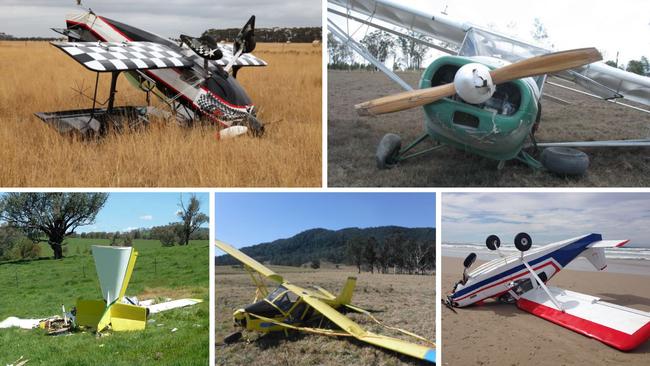Jabiru slams ATSB’s damning engine safety report as ‘biased’
Light aircraft engine maker Jabiru has hit back at a report by the regulator criticising its engine safety record.

The nation’s biggest manufacturer and exporter of light aircraft engines has been savaged by the transport safety regulator, which has found that one in 10 Jabiru engines failed or malfunctioned during flight.
A study by the Australian Transport Safety Bureau found engines built by Jabiru, based in Bundaberg in central Queensland, were more than twice as likely to suffer engine failures, malfunctions, or “spluttering” during flight compared to its competitors.
However, the family-run business, which is a significant player in offshore markets, particularly the US and South Africa, has hit back at the report as “extremely biased”, and misrepresenting key details on numerous fronts.
The ATSB report examined all reported cases of engine failures and malfunctions in light aircraft in Australia in the six years to 2014.
In that time, 322 failures or malfunctions were reported to the ATSB, with 130 involving Jabiru engines, around half due to fractured components, in most cases fractures of “engine through bolt”.
Engine through bolts are bolts which hold together the engine’s crank case, which in turn houses the engine’s pistons.
Jabiru, which builds engines for individual sale as well as aircraft, has been aware of the problems for some time and has stopped using the parts in question.
The ATSB compared Jabiru engine incidents against all other makes which suffered incidents in Australia in the period, but Jabiru and three competitors comprised 94 per cent of engine failures or malfunctions, mainly because they were by far the most popular engine types.
The three competitors in terms of both total incidents and incidents per 10,000 hours flown were Austrian-built Rotax engines, engines built by Textron Lycoming of Pennsylvania and those manufactured by Continental Motors, based in Alabama.
Jabiru general manager Susan Woods, daughter of Jabiru founder and owner Rodd Stiff, said the ATSB report was misleading on a number of fronts.
Jabiru’s “light sport aircraft” engines were compared to more expensive competitors used in heavier aircraft and the report failed to take account of the fact Jabiru’s engines were regularly used in experimental or built-at-home planes and were often more susceptible to backyard tinkering by under-experienced hands.
But a key omission was that based on the ATSB’s own data, Jabiru planes were by far the safest in the market segment based on number of fatalities.
“The report was extremely biased and not up to the standard we expect from the ATSB,” Ms Woods told The Australian.
In the 12 years to December there were 1070 registered Jabiru aircraft and 1092 Cessna 172s in Australia and in that time Jabiru aircraft had seen 0.3 fatalities per 100 registered planes compared with 1.8 fatalities for Cessna 172s.
Planes manufactured by Vans RV, a manufacturer of “kit aircraft” which are put together by owners, were the third most popular in Australia in the “light sport” category.
For each 100 registered planes manufactured by Vans RV there were 2.2 fatalities over the past 12 years.
A US study of light sport aircraft accidents by US publication The Aviation Consumer found Jabiru had the lowest fatality rate there (zero between 2005 and 2012) and the second-lowest overall accident rate behind the Cessna 152.
A key reason for the high engine failure rate but low fatality rate was that lighter planes, such as those using Jabiru engines, were easier to manoeuvre with no power.
Ms Woods said Jabiru was also upset the ATSB had widened its study to include all single-engine aircraft of up to 800kg maximum takeoff weight when light sports aircraft were defined as planes below 600kg.
That change, a deviation from an earlier study by the ATSB, meant Jabiru engines were compared to more expensive and complex engines which were built to more stringent “general aviation” specifications.
“Rotex engines are water cooled and ours are aircooled,” Ms Woods said.
“Aircooled engines require more diligent maintenance, are cheaper to produce but are less complicated and more inviting for people to tinker with”.
Ms Woods said she had examined each of the 130 Jabiru malfunctions and found a range of issues related to maintenance or pilot error, including fuel line blockages and cases where planes ran out of fuel.
In December 2014, aviation regulator the Civil Aviation Safety Authority, based on its own investigation, placed a string of restrictions on Jabiru aircraft, including restricting them to daytime use, requirements they not fly low over populated areas and that all passengers and trainees pilots sign a statement acknowledging the “accept the risk of engine failure”.
Ms Woods said Jabiru had been attempting to have CASA lift those restrictions given it had rectified the “engine through bolt” problem, and that CASA had been impressed with Jabiru’s work but it was waiting on the delivery of the current ATSB report before taking any action.
“It’s a bit rough for us at the moment,” Ms Wood said.



To join the conversation, please log in. Don't have an account? Register
Join the conversation, you are commenting as Logout